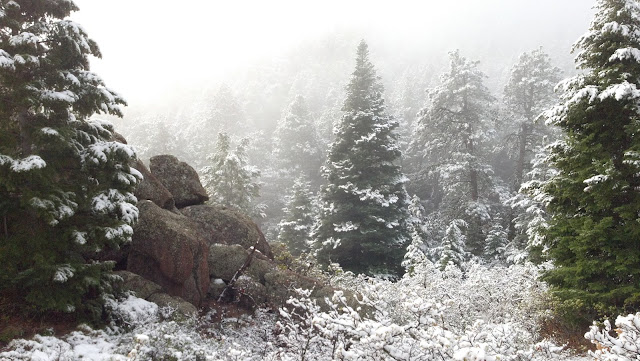Lunch break, thought I would tell about my new goal with lightweight backpacking.
With each of my last two trips, I gained significant amounts of weight over the weekend. Two weekends ago, I gained 4 lbs from Friday morning of the day of my hike to Sunday morning, the day after my hike. I did eat fast food on the way out to hike but I'm pretty sure it wasn't 4 pounds worth. This weekend, I gained over 6 lbs between Friday morning and Sunday morning. I did eat out with my daughter Julia on Saturday night some fish and chips with a milkshake. That didn't seem like 6 more pounds than usual. The crazy thing is that my weight two weeks ago didn't immediately return to my previous weight. I was suspecting some kind of water retention due to the stress of backpacking and that my weight would quickly return to by pre-trip weight.
I didn't track what I ate while hiking, which if I used my
Weight Watchers point values, I would know how many points I was going over. Maybe that would explain the weight gain. I hiked for over 2 hours on Friday and almost 6 hours on Saturday. The 6 hours on Saturday equals 37 points of activity when I normally get to eat 43 points in a day. Weight Watchers must have ultralight backpacking in mind, the description for backpacking is "backpacking, without load (hiking)". I would think 11 pounds of gear and food might count as a little bit of a load. They don't have an activity for backpacking with a load. "Hiking, cross-country" was 37 points for 6 hours as well.
I'll track my WW points next trip. Again, I had leftover food so I guess I can bring even less for an overnighter.
I don't think I'll make any more significant drops in gear's base weight or total weight of everything I carry in my RikSak and lumbar pack. Where I really need to lose is from my own body. I did weight 224 on Friday morning and this morning I weighed 230.4, so I'm actually up 6.4 pounds. My body mass index is 31, which is considered obese. If I can get back down to 224 quick enough, my BMI will be 30, which is the low end of the obese range.
Losing the extra weight to get to a recommended weight of 147 to 184 pounds would mean that I'm carrying 46.4 less pounds even if I only get down to 184 pounds. That is the same as losing 4 of my RikSaks and lumbar packs each with all my gear, water and food. So the new ultralight backpacking push is to keep losing weight from my body. That will definitely save my knees and lower back.
 I had been to Arches two other times in the last few years so I decided to go to some sections that I hadn't gone to before: the Landscape Arch in the Devil's Garden and the Delicate Arch. There were a lot of people hiking, especially college-aged people.
I had been to Arches two other times in the last few years so I decided to go to some sections that I hadn't gone to before: the Landscape Arch in the Devil's Garden and the Delicate Arch. There were a lot of people hiking, especially college-aged people. The Devil's Garden has a one mile hike to the Landscape Arch through lots of rock fins. It reminded me of Garden of the Gods.
The Devil's Garden has a one mile hike to the Landscape Arch through lots of rock fins. It reminded me of Garden of the Gods.




































